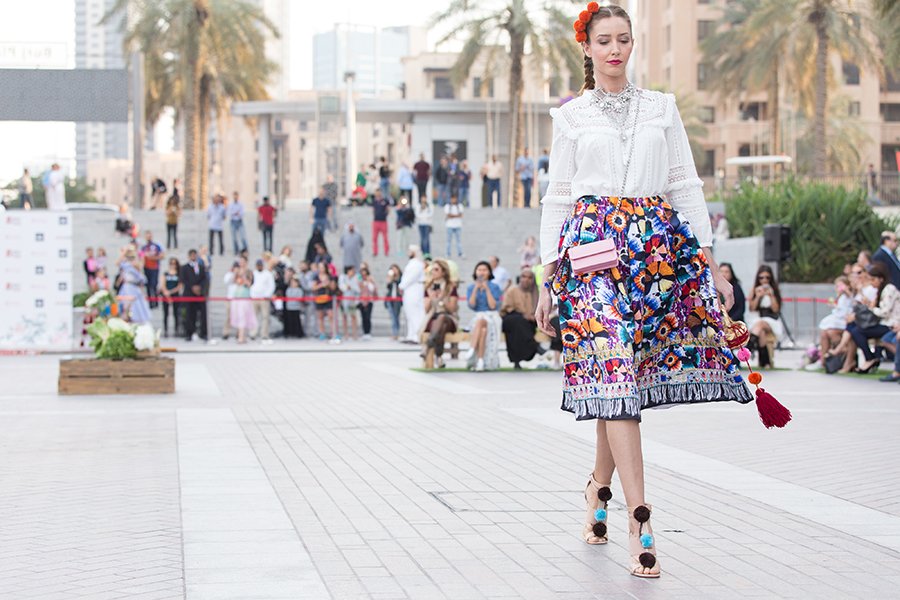
Middle East: A “fashion shapeshifter”
Just a handful of years ago, the UAE and wider Middle East was a little-known the international fashion landscape. Cut to the present, the region has undergone one a dynamic shift. Dubai and Abu Dhabi along with Saudi Arabia and the wider Middle East are not only now on par with the shopping hotspots of New York and Paris – but also presenting a new window of opportunity for the international fashion industry.
From Jimmy Choo to Ray Ban and Bottega Veneta, fashion brands have launched Middle East exclusives of their international ranges. While pop-up stores from luxury fashion houses such as Stella McCartney and Prada have helped place Dubai and the region firmly on the map of haute couture.
And it’s no exaggeration to say that in celebrity-packed fashion shows, the Middle East has fast become a Who’s Who for the biggest names in style.
A fashion shapeshifter
Adding to its fashion reputation, Dubai has morphed from a historical importer of fashion trends to a nascent exporter. Middle Eastern fashion companies are now raising their game with designers, platforms, social media stars and local style trends featuring ever more in the global fashion narrative.
Momentum is building as the Middle East establishes itself as a global hub for emerging talent with regional fashion designers making waves internationally, with A-list celebrities turning to creatives from the UAE, Saudi Arabia, Lebanon, Kuwait and Bahrain to dress them for red carpet runways.
From Kuwaiti designer Yousef Aljasmi dressing Lady Gaga and Kylie Jenner, to luxury UAE-brand Bouguessa styling pop sensation Beyonce. While Lebanese heavyweight Elie Saab is a firm favourite of Hollywood stars.
A dynamic market
“The fashion scene here in the Middle East is becoming more and more exciting. More than ever, we can see what is happening in the region is a lot of ‘newness’. It is an evolution shaping a different fashion and luxury fashion landscape. This was particularly evident post-pandemic,” said Grace Khoury, Vice President Fashion Accessories at Chalhoub Group.
The Middle East, she said, provided a “glimmer of hope” to the international fashion industry as shoppers showed their spending power in the region’s luxury outlets.
“During 2022 which was a huge surprise for us we have seen so many brands making major investments in marketing and collaborations, events and launches.”
The region’s uniquely young demographic also makes the Middle East a “very, very exciting” place on the international fashion scene, she said.
“With a demographic largely under the age of 30, the average shopper in the region is both digitally savvy and informed. They are looking to stand out and are very aware of which brands they would like to purchase from,” Khoury added.
Brands recognise local culture
Recognising that the Gulf is home to discerning shoppers, fashion houses are increasingly staging fashion shows that pay homage to the region’s heritage to capture a dynamic audience. From the Egyptian pyramids to Dubai’s desert dunes and Saudi Arabia’s historical AlUla, each stunning location has been selected by brands to host international fashion events.
Designers are also launching exclusive collections only available in the Middle East, meaning the regional shopper who used to hop on a plane to New York or London for the latest fashion range is staying put and spending locally.
“The Middle East is now a vital hub – and most of the brands have understood that, and therefore have expanded their presence here – especially at a time where governments such as Dubai, UAE and Saudi Arabia have made it easy for them with free zones and visa rule relaxations. All this makes parts of the region a retail heaven,” stated Camelia Georgescu, Vice President Fashion Franchise at Chalhoub Group.
A force to reckon with
The UAE and Middle East are increasingly becoming a force to be reckoned with on the international fashion scene, making big brand names sit up and pay attention, Khoury observed.
“Global brands are, more than ever, focusing on making their brands very relevant for the region. This is what we call localisation, meaning they have their brand identity and global DNA but, at the same time, recognise the need to be relevant to the UAE and Saudi Arabia.”
Brands, she said, have clearly understood that not only they have to place Dubai on the global map, but they need to tailor for special occasions such as Ramadan with special collections and collaborations.
“Salvatore Ferragamo and Versace are good examples,” she said. “They recognise it is extremely important for the younger generation to be trendy and stay ahead of other markets.”
With the UAE and Middle East, a firm fixture on the international fashion scene, Georgescu said the Middle East is going to become the pinnacle of fashion luxury.
“My belief is that in a maximum of five years from now, Dubai and the Middle East is going to be number one on the luxury fashion scene – not only in terms of brand offerings but also in terms of categories and tailor-made exclusive collaborations.”
“What really excites me personally is the fashion industry here is always moving. It is changing and evolving. Our shoppers are very well researched and very informed. They look for reviews, they research the product even before landing in our stores. It creates a market which looks to us for experimentation. Therefore, we pride ourselves on saying that we are market shapers, and we would like to remain so,” Khoury stated.
“In the next five years, I can only see the fashion industry growing, perhaps becoming more exciting. It is not going to be standard. It’s not going to be a mix of global brands, the globalisation of local designers. I can see that exciting times are coming ahead where you have a local consumer, you have a wealthy consumer, you have an international consumer all in one place.”